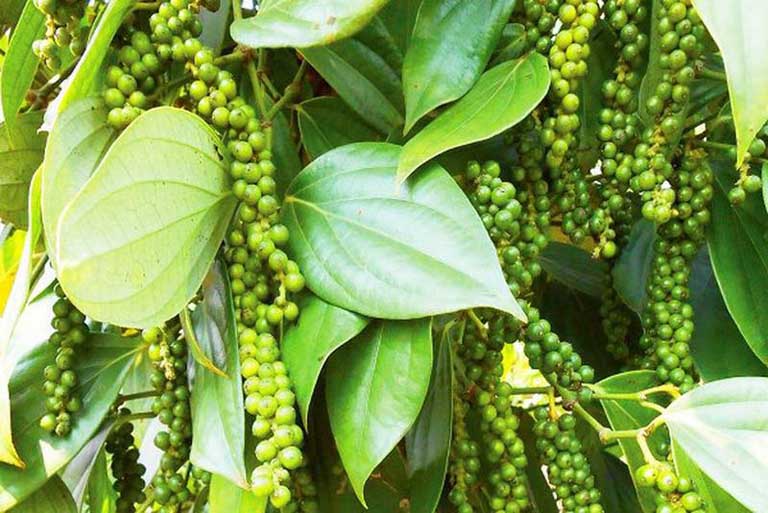Ảnh hưởng của dịch trích lá và rễ cây tràm ta (Melaleuca cajuputi Powell) lên tuyến trùng Meloidogyne spp. gây bướu rễ, nấm Phytophthora spp. VÀ Fusarium spp. gây hại trên cây hồ tiêu (Piper nigrum L.) trong điều kiện phòng thí nghiệm
Nghiên cứu này đánh giá sự ảnh hưởng của các loại dịch trích từ lá (khô và tươi) và rễ tràm lên một số đối tượng gây hại trên tiêu như tuyến trùng Meloidogyne spp., Phytophthora spp. và Fusarium spp. được phân lập từ các vườn hồ tiêu trên địa bàn tỉnh Hậu Giang.

Ảnh minh họa: Internet
Hồ tiêu được trồng phổ biến ở nhiều nơi trên thế giới như Ấn Độ, Brazil, Indonesia, Malaysia, Sri Lanka, Việt Nam và Trung Quốc. Theo Trần Kim Loang, dịch hại trên rễ cây hồ tiêu như rệp sáp, tuyến trùng, nấm Phytopthora đều là những đối tượng có phổ kí chủ rộng nên phòng là chính và cần có các biện pháp phòng trừ đồng bộ kết hợp, trong đó biện pháp canh tác và sinh học là quan trọng. Mô hình trồng tiêu trên thân cây tràm ta (Melaleuca cajuputi Powell) là một mô hình nông – lâm hiệu quả và đang được trồng khá phổ biến ở các tỉnh Kiên Giang, Hậu Giang, Bạc Liêu. . . Tuy nhiên, hiện nay chúng ta chưa có nhiều công bố về sự tác động của dịch trích từ lá và rễ tràm lên sự phát triển của một số tác nhân gây bệnh hại trên cây hồ tiêu. Trong bài báo này, chúng tôi sẽ trình bày sự ảnh hưởng của các loại dịch trích từ cây tràm ta lên sự phát triển của một số đối tượng gây hại chính trên cây hồ tiêu bao gồm Meloidogyne spp., Phytophthora spp. và Fusarium spp. trong điều kiện phòng thí nghiệm.
Kết quả phân lập cho thấy có 10 mẫu tuyến trùng được phân lập từ bướu rễ cây hồ tiêu tại tỉnh Hậu Giang đều có khả năng kí sinh rễ hồ tiêu (Piper nigrum L.) với tỉ lệ kí sinh tăng dần từ một đến bốn ngày sau đặt rễ và đạt đến trên 90%. Bên cạnh đó, có 21 chủng nấm Fusarium spp. sau khi phân lập và khảo sát đặc điểm hình thái được chia thành sáu nhóm với ba nhóm có khả năng gây hại cao được thể hiện bằng kết quả kích thước vết bệnh lớn. Mười sáu chủng nấm Phytophthora spp. thu thập tại tỉnh Hậu Giang dựa vào đặc điểm hình thái được chia thành hai nhóm. Trong đó, nhóm I có khuẩn ti màu trắng đục, sợi nấm tơ mỏng, tơi xốp và phát triển mạnh, tương đối đều và nhóm II có khuẩn ti màu trắng trong, sợi nấm tơ mỏng, không xốp hoặc phát triển không đồng đều.
Kết quả cho thấy việc sử dụng nước thu tại vườn hoặc nước cất để trích lá tràm (tươi và khô) và rễ tràm có làm tăng tỉ lệ tuyến trùng chết và không có sự khác biệt ý nghĩa giữa hai loại dung môi. Dịch trích lá tràm tươi làm tăng tỉ lệ tuyến trùng chết nhanh hơn dịch trích lá tràm khô và dịch trích từ rễ tràm, lần lượt là 100%, 86% và 72% ở 2 NST nhưng không ảnh hưởng lên sự phát triển của cả Fusarium spp. và Phytopthora spp. Dịch trích từ rễ tràm cũng không ảnh hưởng lên sự phát triển của cả Fusarium spp. và Phytopthora spp. trong khi dịch lá tràm khô hạn chế sự phát triển hai chủng nhưng làm tăng nhanh sự phát triển của tám chủng Fusarium spp. trên tổng số 11 chủng được thử nghiệm. Nghiên cứu ảnh hưởng của dịch trích lá và rễ tràm lên các đối tượng gây bệnh hại nêu trên, nhất là tuyến trùng, trong điều kiện nhà lưới và ngoài đồng là cần thiết cũng như xác định thành phần hoạt chất chính làm tăng tỉ lệ chết của tuyến trùng và mở rộng các chủng tuyến trùng gây hại trên các loại cây trồng khác.
nnttien
Tạp chí KH Trường ĐH Trà Vinh, số 34, tháng 6/2019